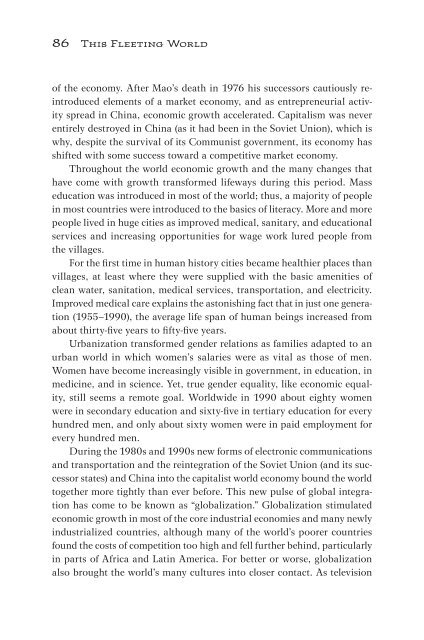This Fleeting World
This Fleeting World
This Fleeting World
Create successful ePaper yourself
Turn your PDF publications into a flip-book with our unique Google optimized e-Paper software.
86 <strong>This</strong> <strong>Fleeting</strong> <strong>World</strong><br />
of the economy. After Mao’s death in 1976 his successors cautiously reintroduced<br />
elements of a market economy, and as entrepreneurial activity<br />
spread in China, economic growth accelerated. Capitalism was never<br />
entirely destroyed in China (as it had been in the Soviet Union), which is<br />
why, despite the survival of its Communist government, its economy has<br />
shifted with some success toward a competitive market economy.<br />
Throughout the world economic growth and the many changes that<br />
have come with growth transformed lifeways during this period. Mass<br />
education was introduced in most of the world; thus, a majority of people<br />
in most countries were introduced to the basics of literacy. More and more<br />
people lived in huge cities as improved medical, sanitary, and educational<br />
services and increasing opportunities for wage work lured people from<br />
the villages.<br />
For the first time in human history cities became healthier places than<br />
villages, at least where they were supplied with the basic amenities of<br />
clean water, sanitation, medical services, transportation, and electricity.<br />
Improved medical care explains the astonishing fact that in just one generation<br />
(1955–1990), the average life span of human beings increased from<br />
about thirty-five years to fifty-five years.<br />
Urbanization transformed gender relations as families adapted to an<br />
urban world in which women’s salaries were as vital as those of men.<br />
Women have become increasingly visible in government, in education, in<br />
medicine, and in science. Yet, true gender equality, like economic equality,<br />
still seems a remote goal. <strong>World</strong>wide in 1990 about eighty women<br />
were in secondary education and sixty-five in tertiary education for every<br />
hundred men, and only about sixty women were in paid employment for<br />
every hundred men.<br />
During the 1980s and 1990s new forms of electronic communications<br />
and transportation and the reintegration of the Soviet Union (and its successor<br />
states) and China into the capitalist world economy bound the world<br />
together more tightly than ever before. <strong>This</strong> new pulse of global integration<br />
has come to be known as “globalization.” Globalization stimulated<br />
economic growth in most of the core industrial economies and many newly<br />
industrialized countries, although many of the world’s poorer countries<br />
found the costs of competition too high and fell further behind, particularly<br />
in parts of Africa and Latin America. For better or worse, globalization<br />
also brought the world’s many cultures into closer contact. As television


